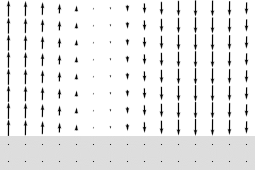Zenneck wave

The Zenneck wave, Zenneck surface wave or Sommerfeld-Zenneck surface wave is a longitudinal, inhomogeneous or non-uniform electromagnetic plane wave incident at the complex Brewster's angle onto a planar or spherical boundary interface between two homogeneous media having different dielectric constants.[1][2][3][4][5][6][7]
The Zenneck wave propagates parallel to the interface and decays exponentially vertical to it, a property known as evanescence. It exists under the condition that the permittivity of one of the materials forming the interface is negative, while the other one is positive, as for example the interface between air and a lossy conducting medium such as the terrestrial transmission line, below the plasma frequency. Arising from original analysis by Arnold Sommerfeld and Jonathan Zenneck of the problem of wave propagation over a lossy earth, it exists as an exact solution to Maxwell's equations.[8]
Recently in 2020, it was demonstrated by Oruganti et al., that it was possible to excite Zenneck wave type waves on flat metal-air interfaces and transmit power across metal obstacles.[9][10]
See also
[edit]- Longitudinal wave
- Body-centric wireless network
- Surface plasmon
- Surface wave
- Wireless energy transmission
References
[edit]- ^ Sommerfeld, A. (1909). "Über die Ausbreitung der Wellen in der drahtlosen Telegraphie" [The Propagation of Waves in Wireless Telegraphy]. Annalen der Physik (in German). 333 (4): 665–736. Bibcode:1909AnP...333..665S. doi:10.1002/andp.19093330402.
- ^ Zenneck, J. (1907). "Über die Fortpflanzung ebener elektromagnetischer Wellen längs einer ebenen Leiterfläche und ihre Beziehung zur drahtlosen Telegraphie" [About the propagation of electromagnetic plane waves along a conductor plane and their relationship to wireless telegraphy]. Annalen der Physik (in German). 328 (10): 846–866. Bibcode:1907AnP...328..846Z. doi:10.1002/andp.19073281003.
- ^ Goubau, G. (1951). "Über die Zennecksche Bodenwelle" [On the Zenneck Surface Wave] (PDF). Zeitschrift für Angewandte Physik (in German). 3 (3/4): 103–107.
- ^ Barlow, Harold Monteagle; Brown, John (1962). "Conditions for the Support of Surface Waves at an Interface Between Two Different Homogeneous Media". Radio Surface Waves. Clarendon Press. pp. 10–12. OCLC 595227169.
- ^ Collin, R.E. (April 2004). "Hertzian dipole radating over a lossy earth or sea: some early and late 20th-century controversies". IEEE Antennas and Propagation Magazine. 46 (2): 64–79. Bibcode:2004IAPM...46...64C. doi:10.1109/MAP.2004.1305535. S2CID 46374504.
- ^ Corum, K.L.; Corum, J.F.; Miller, M.W. (2016). "Surface waves and the 'crucial' propagation experiment — the key to efficient wireless power delivery". 2016 Texas Symposium on Wireless and Microwave Circuits and Systems (WMCS). pp. 1–4. doi:10.1109/WMCaS.2016.7577497. ISBN 978-1-5090-2755-2. S2CID 20413009.
- ^ Corum, K.L. and J.F. Corum, “Bell Labs and the ‘Crucial’ 1936 Seneca Lake Experiment.”[verification needed] Republished as: Corum, James; Corum, Kenneth (2016). "Bell Labs and the Radio Surface Wave Propagation Experiment". In Valone, Tom (ed.). Nikola Tesla's Electricity Unplugged: Wireless Transmission of Power as the Master of Lightning Intended. SCB Distributors. p. 198. ISBN 978-1-939149-67-1.
Any source that can synthesize fields incident at this complex angle will launch a Zenneck wave.
- ^ Barlow, H.; Brown, J. (1962). Radio Surface Waves. London: Oxford University Press. pp. v, vii.
- ^ Oruganti, Sai Kiran; Liu, Feifei; Paul, Dipra; Liu, Jun; Malik, Jagannath; Feng, Ke; Kim, Haksun; Liang, Yuming; Thundat, Thomas; Bien, Franklin (22 January 2020). "Experimental Realization of Zenneck Type Wave-based Non-Radiative, Non-Coupled Wireless Power Transmission". Scientific Reports. 10 (1): 925. Bibcode:2020NatSR..10..925O. doi:10.1038/s41598-020-57554-1. PMC 6976601. PMID 31969594.
- ^ S. K. Oruganti, A. Khosla and T. G. Thundat, "Wireless Power-Data Transmission for Industrial Internet of Things: Simulations and Experiments," in IEEE Access, vol. 8, pp. 187965-187974, 2020, https://doi.org/10.1109/ACCESS.2020.3030658 .
